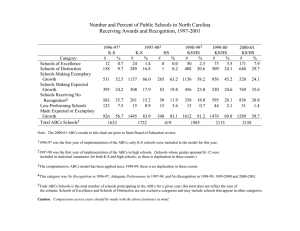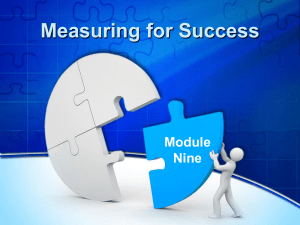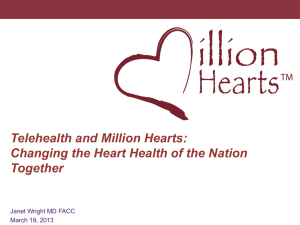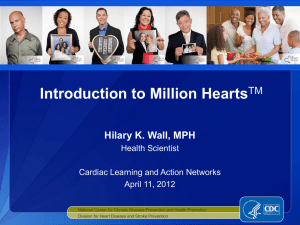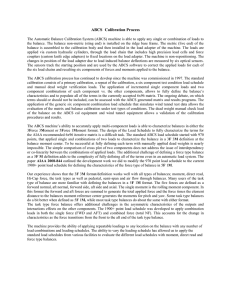Million Hearts Toolkit slideset
advertisement
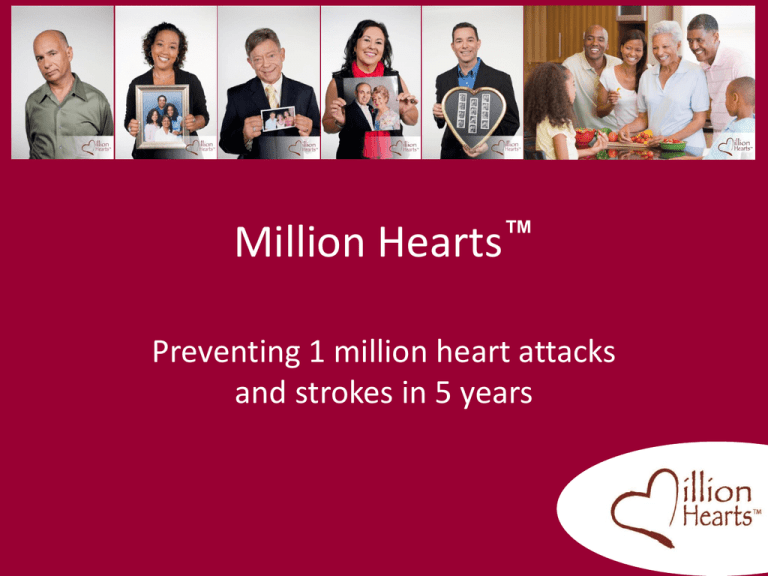
Million ™ Hearts Preventing 1 million heart attacks and strokes in 5 years Heart Disease and Strokes are Leading Killers in the U.S. • Cause 1 of every 3 deaths • Over 2 million heart attacks and strokes each year – 800,000 deaths – Leading cause of preventable death in people < 65 – $444 B in health care costs, lost productivity – Treatment accounts for ~ $1 of every $6 spent • Greatest expression of racial disparities in life expectancy CVD Leading Cause of Shorter Life Expectancy Among African Americans Life expectancy loss for blacks, in months Source: CDC/NCHS, National Vital Statistics System, Mortality, 2007 Status of the ABCS Aspirin People at increased risk of cardiovascular disease who are taking aspirin 47% Blood pressure People with hypertension who have adequately controlled blood pressure 46% Cholesterol People with high cholesterol who have adequately managed hyperlipidemia 33% Smoking People trying to quit smoking who get help 23% Source: MMWR: Million Hearts: Strategies to Reduce the Prevalence of Leading Cardiovascular Disease Risk Factors --- United States, 2011, Early Release, Vol. 60 Number of deaths prevented Improved Cardiovascular Care Could Save 100,000 Lives/Year Percent eligible using service Source: Farley TA, et al. Am J Prev Med 2010;38:600-9. Key Components of Million Hearts™ • Community Prevention – Reduce the number of people who need treatment • Clinical Prevention – Optimize care for those who do Community Prevention Reducing the Number who Need Treatment – Strengthen tobacco control and reduce smoking • Graphic warnings on cigarette packs and ads • Community Transformation Grants – Improve nutrition • Decrease sodium and artificial trans fat consumption Clinical Prevention Optimizing Care for Those who Need it • Focus on the ABCS and align with incentives • Fully deploy HIT to report and improve ABCS performance • Innovate in Care Delivery to improve adherence and control of ABCS Clinical Prevention Focusing and incentivizing the ABCS • Uniform, simplified set of ABCS measures • Getting the ABCS into federal and state programs – Physician Quality Reporting System, – EHR meaningful use criteria – Community clinic measures – Guidelines from private sector organizations – Medicare Part D & MA/PD Plan Ratings – Quality Improvement Organization(s) – Community Transformation Grantee programs Clinical Prevention Information Technology • HIT will enable clinicians to target interventions and support behavior change for clinician and patient – Registries – Point of care clinical decision support – Systematic assessment of cardiac risk – Use of recall reminders and order sets – Monitoring of medication adherence Clinical Prevention Innovations in Care Delivery • Medical and Health Homes, Bundled Care, ACOs – Embedding and incentivizing the ABCS • Mobilize the best change agents – Pharmacists, health coaches, lay workers, community orgs, nurses, clinical peer specialists • Effective ABCS care practices through support, evaluation, and rapid dissemination of innovations – Team-delivered – Adherence-promoting – More continuous and patient-selected Public Sector Support • • • • • • • • • • • • • • Administration on Aging Agency for Healthcare Research and Quality Centers for Disease Control and Prevention Centers for Medicare & Medicaid Services Department of Veterans Affairs Food and Drug Administration Health Resources and Services Administration Indian Health Service National Institutes of Health, National Heart Lung and Blood Institute Substance Abuse and Mental Health Services Administration Office of the Assistant Secretary for Health Office of the National Coordinator of HIT National Prevention Strategy National Quality Strategy Selected Private Sector Support • American Heart Association • America’s Health Insurance Plans • American Pharmacists Association • American Medical Association • The National Community Pharmacists Association • The National Alliance of State Pharmacy Associations and the Alliance for Patient Medication Safety • American Nurses Association • Georgetown University School of Medicine • • • • • • • • • UnitedHealthcare The YMCA of the USA Kaiser Permanente Association of Black Cardiologists American College of Cardiology National Committee for Quality Assurance National Consumer League American Association of Colleges of Pharmacy Walgreens Medical System Messages • Clinicians – Emphasize power of prevention; create systems to get an “A” in the ABCS; use decision supports and registries to drive performance; deploy teams • Pharmacists – Monitor and influence refill patterns; team up; teach adherence! • Insurers – Measure and incentivize performance on the ABCS; collect and share data for quality improvement; empower consumers • Individuals – – – – – Know your numbers—and goals Take aspirin, if advised Get aggressive with BP and Cholesterol Cut sodium and trans-fats If you smoke, quit Community Messages • Retailers and Employers – Offer blood pressure monitoring and educational resources; focus on improving ABCS care in retail and worksite clinics • Government – Support community and systems transformation to reduce tobacco use and improve nutrition, including smoke-free policies and food procurement standards; provide data for action; expand coverage for the uninsured • Foundations – Support consumer and provider outreach and activation • Advocacy groups – Monitor and demand progress toward goal and promote actions that prevent heart attacks and strokes Million Hearts™ : Getting to Goal Baseline 20171 Clinical target2 Aspirin for those at high risk ~50% 65% ~70% Blood pressure control ~50% 65% ~70% Cholesterol management ~33% 65% ~70% Smoking prevalence ~20% 17% ─ 3.5g/day 20% ↓ ─ 1% of calories/day 50% ↓ ─ Population metric Average sodium intake Average artificial trans fat intake 1 Population-wide indicators 2 Clinical systems Million Hearts™ Outcomes • 10M more people with HBP controlled • 20M more people with high cholesterol optimized • 4M fewer people will smoke • 20% drop in average sodium intake • 50% drop in average trans fat intake
